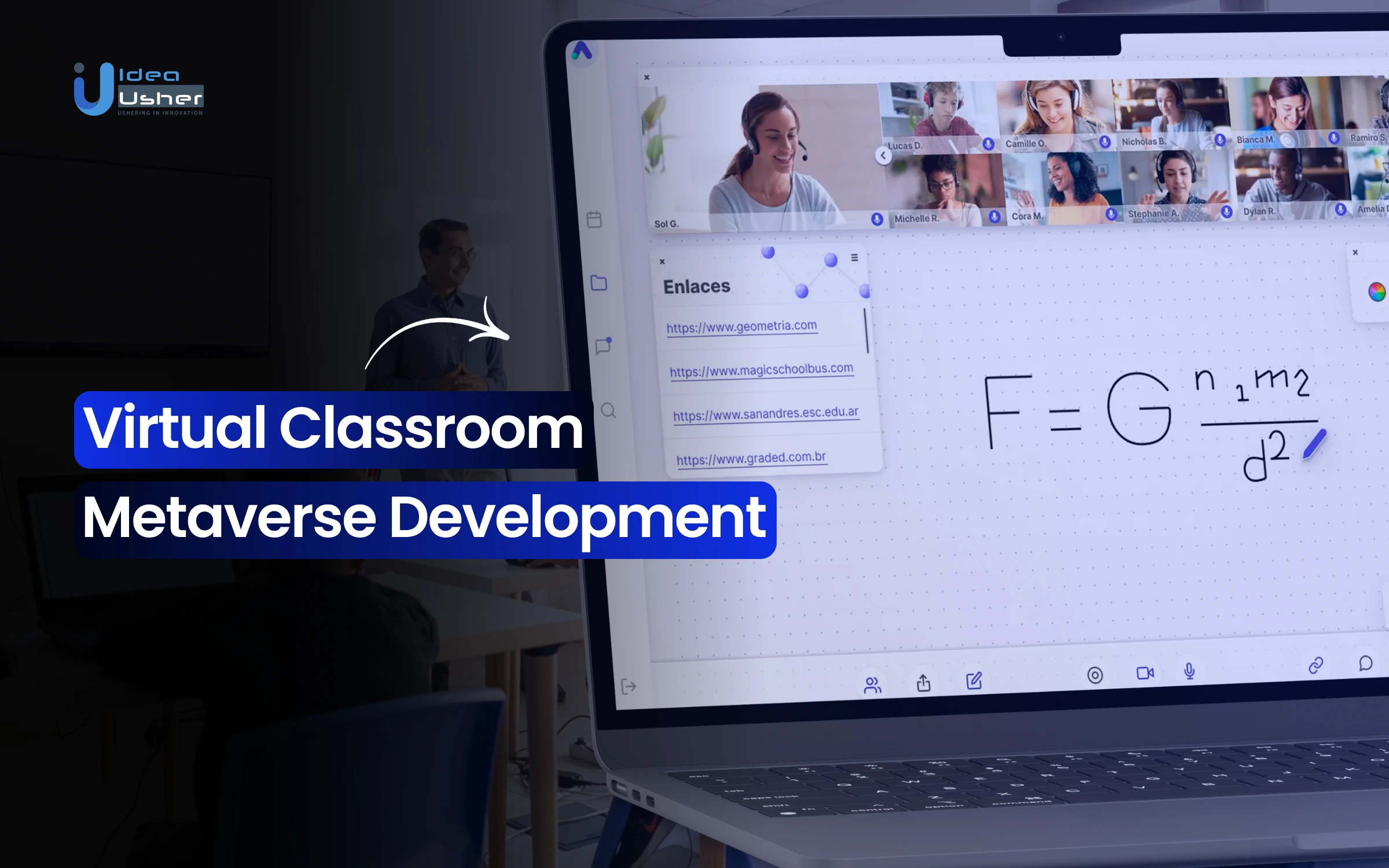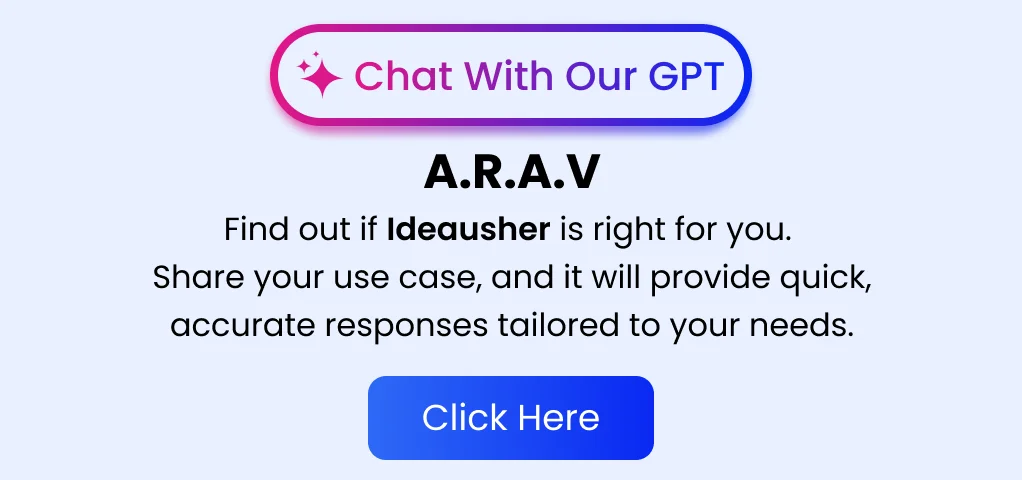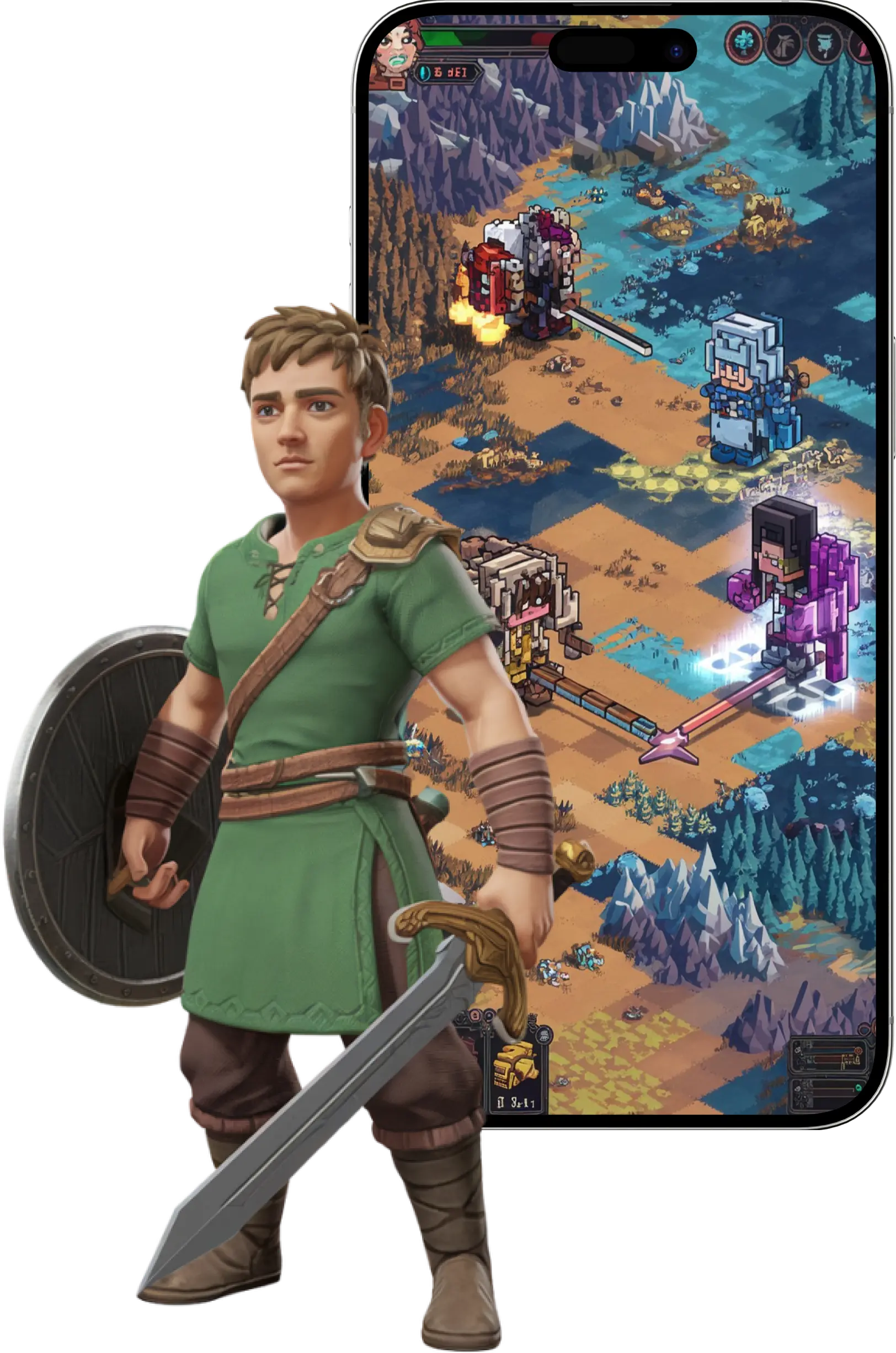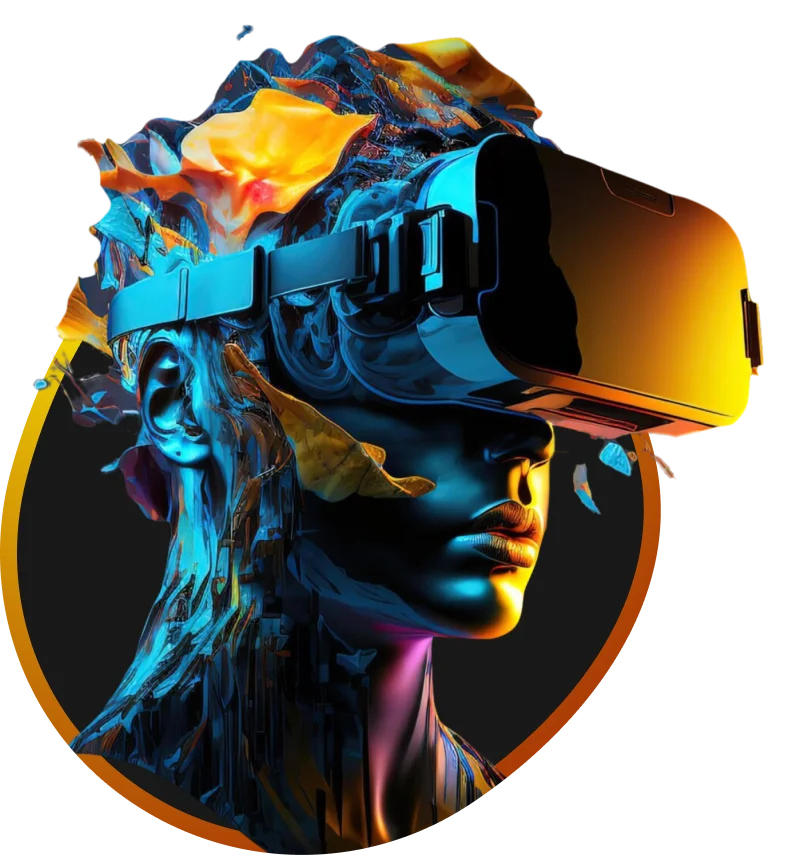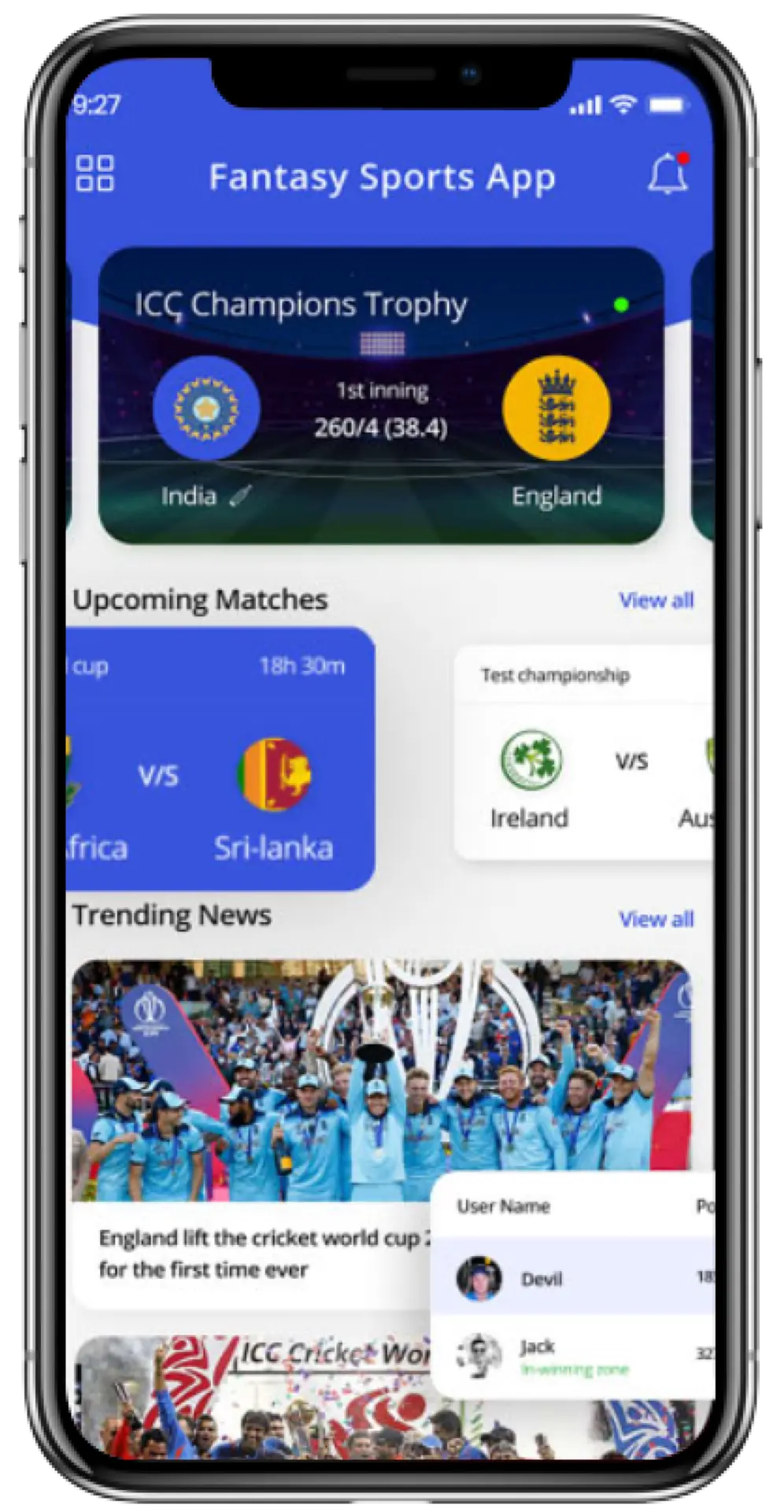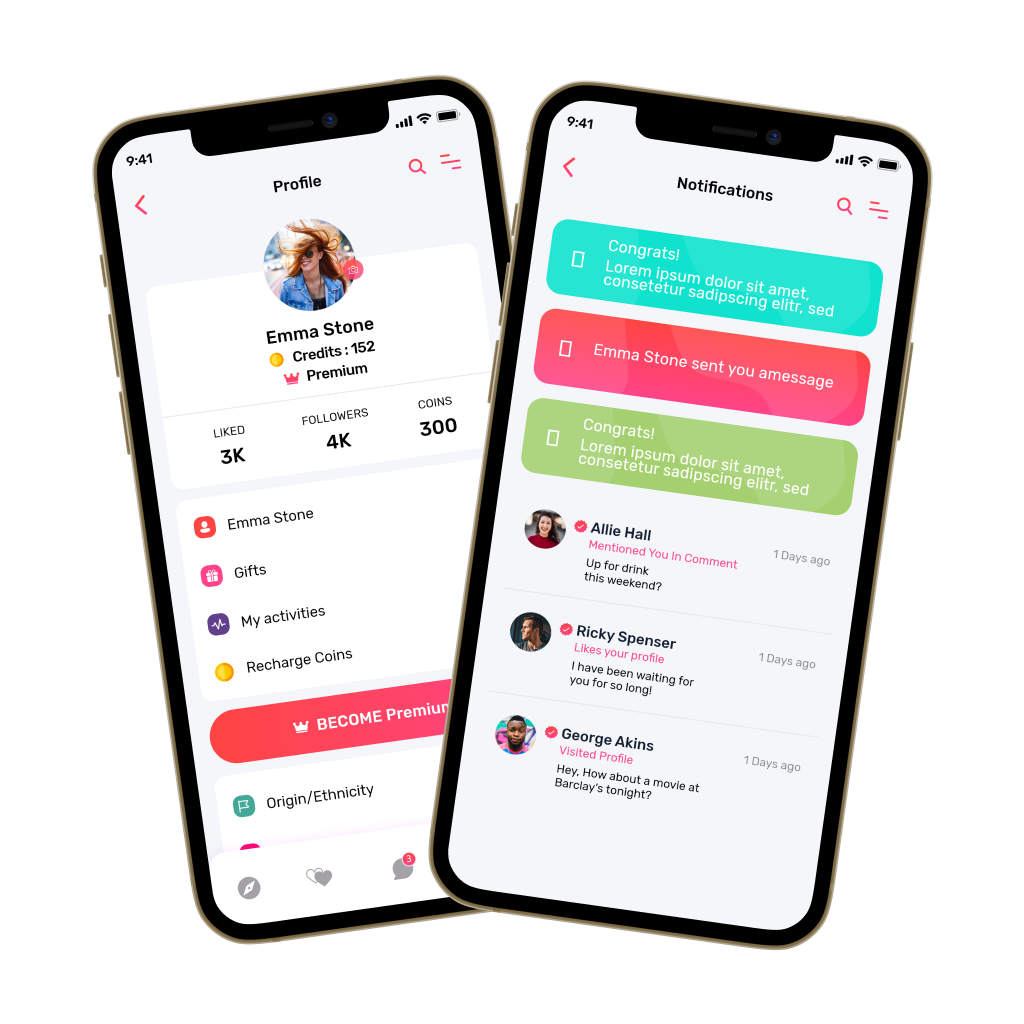The education sector is evolving with the rise of the virtual classroom metaverse, which leverages immersive technologies to enhance learning experiences. By integrating VR, AR, AI, and blockchain, virtual classroom metaverse platforms offer interactive, engaging, and personalized education, transforming how students and educators connect in digital spaces.
A virtual classroom metaverse eliminates geographical barriers, enables real-time collaboration, and provides a dynamic learning environment tailored to individual needs. With technological advancements and increasing adoption, now is the ideal time for institutions and investors to embrace this revolutionary approach to education.
This blog explores the key features, development strategies, costs, top examples of some virtual classroom metaverse and market opportunities that make the virtual classroom metaverse a game-changer for the future of learning.
Key Market Takeaways Of Metaverse In Education
The global metaverse in education market is expected to grow rapidly, valued at USD 7.72 billion in 2024. Projections foresee an increase from USD 10.66 billion in 2025 to USD 176.56 billion by 2034, achieving a CAGR of 36.75%. This surge emphasizes the rising adoption of immersive learning in education.
As the adoption of metaverse-based education accelerates, virtual classrooms are revolutionizing learning experiences by offering interactive and engaging environments for students worldwide. Educational institutions and enterprises are leveraging this technology to enhance accessibility, collaboration, and personalized learning.
As technological advancements continue to revolutionize learning, investing in the virtual classroom metaverse presents a lucrative opportunity. Now is the best time to participate in this transformative shift, ensuring a competitive edge in the future of education.
Types of Virtual Classrooms
Virtual classrooms come in various formats, catering to different learning styles, accessibility needs, and instructional approaches.
Synchronous vs. Asynchronous Learning:
Synchronous: Real-time interaction where students and teachers engage simultaneously through live classes, discussions, and collaborative activities.
Asynchronous: Self-paced learning that allows students to access pre-recorded lectures, assignments, and resources at their convenience.
Pre-Recorded vs. Live Instruction:
Pre-Recorded: Lessons are pre-prepared, enabling students to study at their own pace and revisit content as needed.
Live Instruction: Real time teaching sessions provide immediate engagement, interaction, and feedback from instructors.
General Purpose vs. Subject-Specific Platforms:
General Purpose: Versatile virtual learning environments that support a wide range of subjects and educational needs.
Subject-Specific: Specialized platforms tailored for particular disciplines, such as medical training, STEM education, or language learning.
Open Access vs. Subscription-Based Models:
Open Access: Free-to-use platforms that offer educational content without cost barriers.
Subscription-Based: Platforms that require payment or membership for access to premium content and advanced learning features.
Structured vs. Flexible Learning Environments:
Structured: Organized learning models with predefined schedules, curriculums, and assessments, similar to traditional classrooms.
Flexible: Adaptive learning environments that allow students to customize their learning pace and pathway.
Collaborative vs. Individual Learning Platforms:
Collaborative: Emphasizes teamwork, discussions, and group projects with interactive features for peer engagement.
Individual Learning: Focused on self-guided learning with minimal collaborative components, allowing for independent study.
Gamified vs. Traditional Platforms:
Gamified: Incorporates game-based elements such as rewards, challenges, and interactive simulations to enhance engagement.
Traditional: Follows conventional teaching methods without gamification, maintaining a more academic and structured approach.
Inclusive vs. Specialized Accessibility Platforms:
Inclusive: Designed to accommodate diverse learners, including individuals with varying abilities and learning styles.
Specialized Accessibility: Tailored for specific groups, such as students with disabilities or those requiring adaptive learning tools.
Integrated vs. Standalone Platforms:
Integrated: Seamlessly connects with broader educational ecosystems, including Learning Management Systems (LMS) and institutional infrastructures.
Standalone: Independent platforms developed solely for virtual learning without deep integration into existing educational systems.
Perfect Time To Invest In Virtual Classroom Metaverse
Investing in virtual classroom metaverse platforms offers a transformative opportunity to revolutionize the education sector. The integration of immersive technologies, including VR, AR, and blockchain-enabled credentialing, redefines how students engage with learning, making education more accessible, interactive, and personalized.
Real-world examples, such as Edverse’s Metaverse Classroom and VirBELA, have already demonstrated the potential of immersive digital environments to enhance student engagement and foster global collaboration.
These platforms break down traditional geographical barriers and provide scalable, dynamic solutions that address the evolving needs of modern education.
For investors, the growing adoption of virtual classroom metaverse technologies highlights why now is the best time to invest. Early investments in this rapidly expanding field promise substantial returns and position stakeholders at the forefront of a digital revolution that will reshape global education.
Core Features of Virtual Classroom Metaverse
The virtual classroom metaverse offers advanced features that enhance learning, collaboration, and engagement in a digital environment. These features create an interactive and immersive educational experience for students and instructors.
1. Personalized Avatars
Customizable avatars allow students and instructors to express their identities in virtual spaces. Advanced personalization, including clothing, accessories, and backgrounds, enhances engagement and presence and fosters a more immersive and relatable learning environment.
2. Collaborative Spaces
Live chat, video conferencing, and gesture-based interactions facilitate discussions and group activities. Dedicated virtual spaces for study groups and projects encourage teamwork and deeper learning. These tools enhance communication and make remote collaboration seamless.
3. Interactive Learning Tools
Real-world simulations help students experience practical scenarios like job interviews or medical training. Whiteboards, quizzes, and breakout rooms promote interactive and collaborative learning. These elements create engaging, hands-on educational experiences.
4. Content & LMS Integration
Students and instructors can share slides, documents, and videos for an engaging learning experience. Seamless integration with LMS platforms simplifies course management, grading, and attendance tracking, ensuring efficient organization and accessibility of learning materials.
5. Inclusive Access
Accessible on multiple devices, virtual classrooms offer learning flexibility. Features like screen readers, subtitles, and customizable interfaces ensure inclusivity for all students. These improvements make education more accessible to diverse learners.
6. Gamified Learning
Leaderboards, badges, and rewards motivate students and enhance engagement by making learning more interactive and enjoyable. Gamification encourages active participation and a sense of achievement.
7. AI-Powered Learning & Tutoring
AI-driven tutors provide personalized learning paths, instant feedback, and resource recommendations based on individual student needs and performance. This enhances adaptive learning and ensures better academic outcomes.
8. 3D & Immersive Learning
3D models and simulations simplify complex concepts, especially in science and engineering. VR and AR integration enhances hands-on learning with virtual labs and interactive experiences. These technologies create realistic and engaging educational environments.
9. Assessments & Analytics
Instant feedback through quizzes and peer assessments helps students track their progress. Educators can analyze student engagement and performance data to refine teaching strategies, leading to continuous improvement in learning experiences.
Development Steps of Virtual Classroom Metaverse
Building a virtual classroom metaverse requires a strategic approach, combining educational expertise with cutting-edge technology. Below are the key steps to ensure a seamless and engaging learning experience.
1. Define Goals & Requirements
Outline clear objectives for the virtual classroom, considering age groups, subjects, and assessments. Collaborate with educators and stakeholders to align the platform with learning needs and standards. Create a structured plan detailing user experience, interaction methods, and content types. A well-defined blueprint will guide development and ensure a smooth transition from concept to execution.
2. Consult Reputed Company
Consult with reputed companies like IdeaUsher’s market researchers and tech teams to analyze existing educational technologies and competitor platforms to identify market gaps and opportunities. Understanding user expectations and industry trends will help in defining unique features that appeal to the target audience.
3. Assemble A Team
Assemble a team of experts in education, game design, VR/AR development, and software engineering. A diverse team ensures that the platform is built with a balance of technological innovation and effective pedagogy. Collaborating with instructional designers and AI specialists can further enhance adaptive learning experiences.
4. Choose The Right Tech Stack
Choose the appropriate technologies to support immersive learning experiences. Game engines like Unity or Unreal Engine are used for 3D development, WebXR is used for browser-based VR experiences, and ARKit or ARCore is used for mobile AR integration. Implement cloud computing solutions such as AWS, Google Cloud, or Firebase for scalability and storage. Use blockchain (Ethereum, Hyperledger) for credential verification and secure transactions if needed.
5. UI/UX Development
Focus on an intuitive and visually appealing interface to enhance user engagement. Utilize Figma, Adobe XD, or Sketch for prototyping and designing wireframes. Implement React.js or Vue.js for front-end development, ensuring smooth navigation and accessibility. Additionally, AI-driven personalization should be incorporated to adapt the interface based on user preferences and behavior.
6. Develop Core Features
Develop essential features such as customizable avatars, interactive whiteboards, video conferencing, and content-sharing tools. Use WebRTC for real-time video/audio communication, Three.js or Babylon.js for rendering 3D environments, and Firebase or MongoDB for data management. Incorporate gamification strategies using PlayFab, Gamify API, or Open Badge to implement reward systems, leaderboards, and badges.
7. Add Gamification & Collaboration Tools
Integrate group discussion areas, breakout rooms, and peer assessment tools to encourage collaboration. Use Agora or Twilio for live chat and video collaboration and Google Forms, Kahoot, or Mentimeter for real-time quizzes and polling.
8. Integrate Data Analytics & Reporting
Set up analytics tools to monitor student progress, engagement levels, and learning outcomes. Implement Google Analytics, Mixpanel, or Tableau to track user interactions. Use AI-based learning analytics (TensorFlow, PyTorch) to provide personalized recommendations and predictive insights.
9. Conduct Testing
Perform extensive usability testing with students and educators to ensure functionality, accessibility, and performance. Use Selenium, Cypress, or Jest for automated testing and Lighthouse for performance optimization. Address any issues through iterative debugging and optimization before the official launch.
10. Launch & Improvement
Roll out the platform in phases, starting with a pilot launch to gather user feedback. Use DevOps tools like Docker, Kubernetes, and Jenkins for deployment and continuous integration. Regularly update features based on technological advancements and user input to enhance the learning experience.
Cost of Developing Virtual Classroom Metaverse
The development cost of a Virtual Classroom Metaverse varies based on features, technology stack, and complexity. Below is a cost breakdown
| Development Steps | Task | Description | Estimated Cost |
| Define Goals & Requirements | Outline objectives | Identify learning needs, target users, and content requirements. | $2,000 – $8,000 |
| Consult Reputed Company | Market research & feasibility study | Consult experts to analyze market gaps and define core features. | $3,000 – $10,000 |
| Assemble A Team | Hire developers & designers | Form a team including developers, designers, and education specialists. | $5,000 – $15,000 |
| Choose The Right Tech Stack | Select suitable technologies | Choose VR/AR tools, game engines, and blockchain solutions. | $4,000 $12,000 |
| UI/UX Development | Design interface & wireframes | Create interactive, accessible, and engaging UI/UX. | $5,000 – $15,000 |
| Develop Core Features | Build essential functionalities | Implement avatars, content sharing, real time collaboration tools. | $10,000 – $25,000 |
| Gamification & Collaboration Tools | Enhance engagement | Integrate badges, leaderboards, group projects, and interactive elements. | $5,000 – $12,000 |
| Integrate Data Analytics & Reporting | Performance tracking | Implement analytics to assess learning outcomes. | $4,000 – $10,000 |
| Conduct Testing | QA & bug fixing | Test usability, security, and performance. | $5,000 – $8,000 |
| Launch & Improvement | Deploy and update | Deploy the platform and continuously refine features based on feedback. | $7,000 – $15,000 |
Total Estimated Cost: $10,000 – $100,000
Future Trends of Virtual Classroom Metaverse
The evolution of the virtual classroom metaverse is set to revolutionize education by integrating advanced technologies, creating a more immersive and inclusive learning experience.
1. Use Of AR & VR
As VR and AR technologies continue to advance, virtual classrooms will offer highly immersive environments that mimic real-world experiences. Students will engage in hands-on learning through lifelike simulations, interactive 3D models, and virtual field trips, making education more engaging and practical.
2. AI-Powered Personalization
Artificial intelligence will drive adaptive learning systems, analyzing student progress, preferences, and challenges to customize learning paths. AI-powered virtual tutors will provide real-time feedback, ensuring that students receive personalized support tailored to their needs.
3. Global Classrooms
Virtual classrooms will eliminate geographical limitations, enabling cross-cultural learning where students from different parts of the world can collaborate in real time. This fosters global discussions, cultural exchange, and broader perspectives, enriching the overall educational experience.
4. Integration of IoT Devices
The Internet of Things (IoT) will enhance learning by connecting smart devices that enable real-time interactions. Teachers can use IoT-enabled tools for live experiments, automated attendance tracking, and personalized insights based on student engagement and response patterns.
5. Focus on Social-Emotional Learning (SEL)
The future of education will prioritize holistic development, incorporating tools to improve emotional intelligence, collaboration, and mental well-being. Virtual environments will include AI-driven emotion recognition and interactive group activities to help students develop crucial social-emotional skills.
6. Blockchain for Credentialing
Blockchain technology will revolutionize secure credentialing, allowing students to earn and share digital certificates with universities and employers. These verifiable credentials will eliminate fraudulent certifications and create a trusted system for academic and professional recognition.
Top Examples Of Virtual Classroom in Metaverse
1. Edverse Metaverse Classroom
A comprehensive metaverse-based education platform designed for immersive and interactive learning experiences, allowing students and educators to engage in virtual classrooms with AI-powered personalization.
2. VirBELA
A virtual campus that enables remote learning, collaboration, and networking in an engaging 3D environment, making it ideal for online universities, corporate training, and global education programs.
3. Engage VR
A VR-based learning platform that offers immersive educational experiences for students and corporate training, featuring real-time collaboration, virtual field trips, and interactive lectures.
4. ClassVR
A mixed-reality learning solution that enhances classroom engagement through VR and AR technologies, providing hands-on experiences in subjects like science, history, and engineering.
5. Immerse Learning
A virtual training and education platform that provides interactive and skill-based learning experiences, helping businesses and educational institutions upskill their workforce and students.
Conclusion
The rise of virtual classroom metaverse platforms is transforming the education landscape, making learning more immersive, interactive, and globally accessible. This article has provided a comprehensive roadmap for developing a virtual classroom metaverse, covering essential steps, key technologies, and the estimated cost of development. By understanding these aspects, businesses and investors can make informed decisions and create platforms that meet modern educational demands.
With the right strategy, technology stack, and investment, building a successful virtual classroom metaverse is within reach. As the market continues to expand, now is the ideal time to innovate and invest in this evolving digital learning space.
Want to Develop a Virtual Classroom Metaverse?
With over 500,000 hours of coding expertise, we specialize in building immersive virtual classroom metaverse platforms that transform learning experiences. Our cutting-edge solutions integrate AI, VR, AR, and blockchain to create interactive, engaging, and accessible education environments. From personalized learning paths to real-time collaboration tools, we empower educators and institutions to revolutionize the way knowledge is delivered. Partner with Idea Usher to build the future of digital education and redefine the classroom experience for students worldwide.
Work with Ex-MAANG developers to build next-gen apps schedule your consultation now
FAQs
Q.1. How is the metaverse used in education?
The metaverse enhances education by creating immersive virtual environments where students can engage in interactive learning experiences. It facilitates virtual classrooms, hands-on simulations, collaborative projects, and gamified learning, making education more engaging and accessible.
Q.2. How can the metaverse revolutionize learning?
The metaverse can revolutionize learning by breaking geographical barriers, providing real-time collaboration, and enabling experiential education through virtual labs, 3D simulations, and AI-powered tutors. It fosters personalized learning, enhances student engagement, and makes complex concepts easier to understand.
Q.3. How does AI contribute to the enhancement of virtual education within the metaverse?
AI plays a crucial role in metaverse education by personalizing learning experiences, analyzing student performance, and providing real-time feedback. AI-powered virtual tutors, automated assessments, and intelligent content recommendations help students learn at their own pace while improving knowledge retention.
Q.4. How can the metaverse change training and development?
The metaverse transforms training and development by offering realistic simulations, interactive role-playing, and virtual workshops for industries such as healthcare, aviation, and corporate training. It allows employees to practice skills in a risk-free environment, enhancing learning efficiency and retention.
